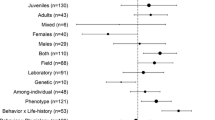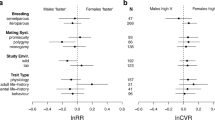Abstract
Variation in life history (LH) traits along the fast-slow continuum (referred to as pace of life, POL) is thought to result from a trade-off between investments in current versus future reproduction. Originally developed for understanding variation in LH strategies at the among-population level, the POL theory has more recently been applied towards understanding variation in LH traits at the within-population level, and further extended to address the covariance of LH traits with additional behavioural and/or physiological traits, referred to as pace-of-life syndromes (POLS). The article by Réale et al. (Philos T Roy Soc B 365:4051–4063, 2010), which synthesized several earlier reviews and opinions on among-individual covariation between LH, behavioural, and physiological traits, and subsequent research testing POLS in a variety of species, have collectively been cited several hundreds of times—a trend that continues. These works have interdisciplinary impact, informing research in life history biology, behavioural and developmental biology, and the social sciences. In this paper, we review the existing theoretical POLS models that provide adaptive explanations for covariances between LH traits and additional behavioural and/or physiological traits while assuming a trade-off between current and future reproduction. We find that the set of relevant models is small. Moreover, models show that covariances between life history traits and behavioural or physiological traits can arise even in the absence of a current-future reproduction trade-off, implying that observing such covariances does not provide a strong indication regarding the process generating POLS. We discuss lessons learned from existing models of POLS, highlight key gaps in the modelling literature, and provide guidelines for better integration between theory and data.
Similar content being viewed by others
References
Baldauf SA, Engqvist L, Weissing FJ (2014) Diversifying evolution of competitiveness. Nat Commun 5:5233
Baldini R (2015) Harsh environments and “fast” human life histories: what does the theory say?. BioRxiv https://doi.org/101101/014647
Bell AM, Hankison SJ, Laskowski KL (2009) The repeatability of behaviour: a meta-analysis. Anim Behav 77:771–783
Belsky J, Steinberg L, Draper P (1991) Childhood experience, interpersonal development, and reproductive strategy: an evolutionary theory of socialization. Child Dev 62:647–670
Biro PA, Stamps JA (2008) Are animal personality traits linked to life-history productivity? Trends Ecol Evol 23:361–368
Biro PA, Stamps JA (2010) Do consistent individual differences in metabolic rate promote consistent individual differences in behavior? Trends Ecol Evol 25:653–659
Careau V, Garland T (2012) Performance, personality, and energetics: correlation, causation and mechanism. Physiol Biochem Zool 85:543–571
Careau V, Thomas DK, Humphries MM, Réale D (2008) Energy metabolism and animal personality. Oikos 117:641–653
Carter AJ, Feeney WE, Marshall HH, Cowlishaw G, Heinsohn R (2013) Animal personality: what are behavioural ecologists measuring? Biol Rev 88:465–475
Chan MHT, Kim PS (2014) An age-structured approach to modelling behavioural variation maintained by life-history trade-offs. PLoS One 9
Charlesworth B (1990) Optimization models, quantitative genetics, and mutation. Evolution 44:520–538
Clark CW (1994) Antipredator behavior and the asset-protection principle. Behav Ecol 5:159–170
Dammhahn M, Dingemanse NJ, Niemelä P, Réale D (2018) Pace-of-life syndromes: a framework for the adative integration of personality and life-history. Behav Ecol Sociobiol. https://doi.org/10.1007/s00265-018-2473-y
Del Giudice M, Gangestad SW, Kaplan HS (2015) Life history theory and evolutionary psychology. In: Buss DM (ed) The handbook of evolutionary psychology. Wiley, New York, pp 88–114
Delaguerie P, Olivieri I, Atlan A, Gouyon PH (1991) Analytic and simulation-models predicting positive genetic correlations between traits linked by trade-offs. Evol Ecol 5:361–369
van Doorn GS, Wolf M, Leimar O, Weissing FJ (2009) Animal personalities and the divergence of life-histories. In Adaptive individual differences. In: Faculty of Mathematics and Natural Sciences. University of Groningen, the Netherlands
Ellis BJ, Figueredo AJ, Brumbach BH, Schlomer GL (2009) Fundamental dimensions of environmental risk. Hum Nat 20:204–268
Engqvist L, Cordes N, Reinhold K (2015) Evolution of risk-taking during conspicuous mating displays. Evolution 69:395–406
Frankenhuis WE, Panchanathan K, Clark Barrett H (2013) Bridging developmental systems theory and evolutionary psychology using dynamic optimization. Dev Sci 16:584–598
Hämäläinen A, Immonen E, Schuett W, Tarka M (2018) Sex-specific secltion and the evolution of pace-of-life syndromes. Behav Ecol Sociobiol. https://doi.org/10.1007/s00265-018-2466-x
Holtmann B, Lagisz M, Nakagawa S (2016) Metabolic rates, and not hormone levels, are a likely mediator of between-individual differences in behaviour: a meta-analysis. Funct Ecol:n/a-n/a
Houle D (1991) Genetic covariance of fitness correlates: what genetic correlations are made of and why it matters. Evolution 45:630–648
Houston AI, McNamara JM (1989) The value of food: effects of open and closed economies. Anim Behav 37:546–562
Houston AI, McNamara JM (1999) Models of adaptive behaviour: an approach based on state. Cambridge University Press, Cambridge
de Jong G (1993) Covariances between traits deriving from successive allocations of a resource. Funct Ecol 7:75–83
de Jong G, van Noordwijk AJ (1992) Acquisition and allocation of resources: genetic (co) variances, selection, and life histories. Am Nat 139:749–770
Jonsson KI, Tuomi J, Jaremo J (1998) Pre- and postbreeding costs of parental investment. Oikos 83:424–431
Luttbeg B, Sih A (2010) Risk, resources and state-dependent adaptive behavioural syndromes. Philos Trans R Soc B 365:3977–3990
Mallpress DEW, Fawcett TW, Houston AI, McNamara JM (2015) Risk attitudes in a changing environment: an evolutionary model of the fourfold pattern of risk preferences. Psychol Rev 122:364–375
Mangel M, Clark CW (1988) Dynamic modeling in behavioral ecology. Princeton University Press
Mangel M, Stamps J (2001) Trade-offs between growth and mortality and the maintenance of individual variation in growth. Evol Ecol Res 3:583–593
Martin LBI, Hasselquist D, Wikelski M (2006) Investment in immune defense is linked to pace of life in house sparrows. Oecologia 147:565–575
Mathot KJ, Dingemanse NJ (2015) Behaviour and energetics: unrequited needs and new directions. Trends Ecol Evol 30:199–206
McElreath R, Strimling P (2006) How noisy information and individual asymmetries can make ‘personality’ an adaptation: a simple model. Anim Behav 72:1135–1139
McElreath R, Luttbeg B, Fogarty SP, Brodin T, Sih A (2007) Evolution of animal personalities. Nature 450:E5–E5; discussion E6
McNamara JM, Houston AI (1996) State-dependent life histories. Nature 380:215–221
Metcalfe CJ (2016) Invisible trade-offs: van Noordwijk and de Jong and life-history evolution. Am Nat 187:iii–iiv
Moher D, Liberati A, Tetzlaff J, Altman DG, The PG (2009) Preferred reporting items for systematic reviews and meta-analyses: the PRISMA statement. PLoS Med 6:e1000097
Montiglio PO, Dammhahn M, Dubuc Messier G, Réale D (2018) The pace-of-life syndrome hypothesis: evidence, limitations and future directions. Behav Ecol Sociobiol (in press)
Mullon C, Keller L, Lehmann L (2016) Evolutionary stability of jointly evolving traits in subdivided populations. Am Nat 188:175–195
van Noordwijk AJ, de Jong G (1986) Acquisition and allocation of resources: their influence on variatio in life history tactics. Am Nat 128:137–142
Réale D, Reader SM, Sol D, McDougall PT, Dingemanse NJ (2007) Integrating animal temperament within ecology and evolution. Biol Rev 82:291–318
Réale D, Garant D, Humphries MM, Bergeron P, Careau V, Montiglio P-O (2010) Personality and the emergence of the pace-of-life syndrome concept at the population level. Philos Trans R Soc B 365:4051–4063
Ricklefs RE (2000) Lack, Skutch, and Moreau: the early development of life-history thinking. Condor 102:3–8
Ricklefs RE, Wikelski M (2002) The physiology/life-history nexus. Trends Ecol Evol 17:462–469
Riska B (1986) Some models for development, growth, and morphometric correlation. Evolution 40:1303–1311
Royauté R, Berdal MA, Garrison C, Dochtermann NA (2018) Paceless life? A meta-analysis of the “pace-of-life syndrome”. Behav Ecol Sociobiol. https://doi.org/10.1007/s00265-018-2472-z
Saether B-E (1988) Pattern of covariation between life-history traits of European birds. Nature 331:616–617
Sibly R, Calow P (1984) Direct and absorption costing in the evolution of life cycles. J Theor Biol 111:463–473
Smith BR, Blumstein DT (2008) Fitness consequences of personality: a meta-analysis. Behav Ecol 19:448–455
Stamps JA (2007) Growth-mortality tradeoffs and ‘personality traits’ in animals. Ecol Lett 10:355–363
Stamps JA, Frankenhuis WE (2016) Bayesian models of development. Trends Ecol Evol 31:260–268
Stamps J, Phillips JA, Mangel M (1998) A new look at relationships between size at maturity and asymptotic size. Am Nat 152:470–479
Stearns SC (1992) The evolution of life histories. Oxford University Press, Oxford
Teriokhin AT (1998) Evolutionarily optimal age schedule of repair: computer modelling of energy partition between current and future survival and reproduction. Evol Ecol 12:291–307
Williams GC (1966) Natural selection, the costs of reproduction, and a refinement of Lack’s principle. Am Nat 100:687–690
Wolf M, McNamara JM (2012) On the evolution of personalities via frequency-dependent selection. Am Nat 179:679–692
Wolf M, van Doom GS, Leimar O, Weissing FJ (2007a) Wolf et al. reply. Nature 450:E5–E6
Wolf M, van Doorn GS, Leimar O, Weissing FJ (2007b) Life-history trade-offs favour the evolution of animal personalities. Nature 447:581–584
Wolf M, van Doorn GS, Weissing FJ (2008) Evolutionary emergence of responsive and unresponsive personalities. PNAS 105:15825–15830
Wolf M, Van Doorn GS, Weissing FJ (2011) On the coevolution of social responsiveness and behavioural consistency. Proc R Soc B 278:440–448
Worley AC, Houle D, Barrett SCH (2003) Consequences of hierarchical allocation for the evolution of life-history traits. Am Nat 161:153–167
Acknowledgements
The idea for this paper developed from discussions during a Volkswagon Stiftung Workshop “Towards a General Theory of Pace of Life” [89905]. We thank the workshop organizers, Melanie Dammhahn, Niels Dingemanse, Petri Niëmela, and Denis Réale, for inviting us to participate in this workshop. KJM and WEF were each supported by Veni Fellowships (KJM: 863.14.021, WEF: 016.155.195) from the Netherlands Organisation for Scientific Research (NWO, Nederlandse Organisatie voor Wetenschappelijk Onderzoek) while writing this paper. We thank Melanie Dammhahn, Max Wolf, and Pierre-Olivier Montiglio and one anonymous referee for commenting on a previous version of the manuscript.
Author information
Authors and Affiliations
Corresponding author
Additional information
Communicated by M. Dammhahn
This article is a contribution to the Topical Collection Pace-of-life syndromes: a framework for the adaptive integration of behaviour, physiology and life-history – Guest Editors: Melanie Dammhahn, Niels J. Dingemanse, Petri T. Niemelä, Denis Réale
Electronic supplementary material
ESM 1
(DOCX 33 kb)
Rights and permissions
About this article
Cite this article
Mathot, K.J., Frankenhuis, W.E. Models of pace-of-life syndromes (POLS): a systematic review. Behav Ecol Sociobiol 72, 41 (2018). https://doi.org/10.1007/s00265-018-2459-9
Received:
Revised:
Accepted:
Published:
DOI: https://doi.org/10.1007/s00265-018-2459-9




